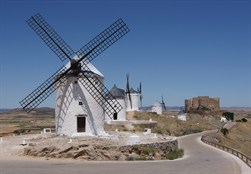La Mancha
 La Mancha is a territory which historically occupied the center of the Iberian Peninsula. Cities as the current Toledo, Ciudad Real, Cuenca and Albacete are part of it. It has been inhabited since prehistoric times, and then by the Iberians, Romans and Visigoths. The region is eminently agricultural and the lack of water has marked the economy and the way of life of its inhabitants. This is confirmed by the very origin of the Spanish name “La Mancha”, which comes from the Arabic, meaning “dry land”. The territory passed into the hands of the military Orders during the Reconquista, when it was necessary to repopulate and defend the lands which had just been regained. La Mancha was then divided between the Orders of San Juan, Santiago and Calatrava, which administered it until the Catholic Monarchs (1474-1516) took over the government. At the beginning of the seventeenth century, Miguel de Cervantes gave La Mancha further signs of identity through the landscapes and places described in the Quijote which still exist today.
La Mancha is a territory which historically occupied the center of the Iberian Peninsula. Cities as the current Toledo, Ciudad Real, Cuenca and Albacete are part of it. It has been inhabited since prehistoric times, and then by the Iberians, Romans and Visigoths. The region is eminently agricultural and the lack of water has marked the economy and the way of life of its inhabitants. This is confirmed by the very origin of the Spanish name “La Mancha”, which comes from the Arabic, meaning “dry land”. The territory passed into the hands of the military Orders during the Reconquista, when it was necessary to repopulate and defend the lands which had just been regained. La Mancha was then divided between the Orders of San Juan, Santiago and Calatrava, which administered it until the Catholic Monarchs (1474-1516) took over the government. At the beginning of the seventeenth century, Miguel de Cervantes gave La Mancha further signs of identity through the landscapes and places described in the Quijote which still exist today.
